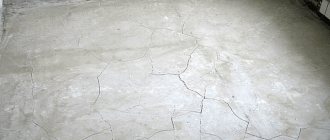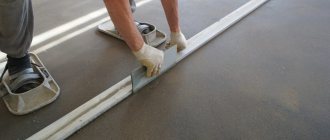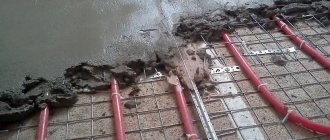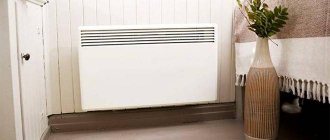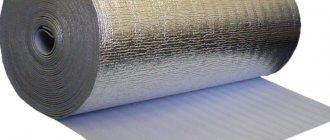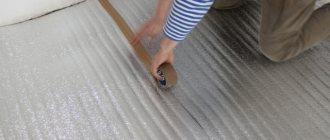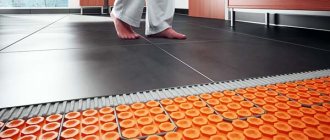Damper tape for warm floors (otherwise known as heat-shrink tape) is a special tape that can compensate for temperature fluctuations, which helps prevent the destruction of the screed when encountering resistance from the wall.
The damper tape also performs the function of sealing at the joints of the plates. Since the cement screed solution assumes the presence of a certain amount of water, which can seep below and spread, to prevent this, damper tape is used at the junctions of wall and floor slabs, as well as floor slabs.
Is it always necessary to use damper tape?
The damper tape is nothing more than a strip of polyethylene foam. This material is very light, soft, easy and simple to work with, so the installation process itself does not require any special skills and does not take much time. This point also had an important impact on the popularity of using this invention in the construction of various types of screeds. It is recommended to use damper tape for:
- organization of floors using the “warm floor” system;
- when performing dry or semi-dry screed.
The only case when can be neglected is when pouring self-leveling solutions. This is due both to the small thickness of their layer and to the fact that self-levelers are essentially classified as contact types of coatings.
For information , a traditional screed based on a cement-sand mixture is capable of expanding when the temperature rises by 0.5 mm per linear meter. Just imagine with what force the screed will press in a room of 10 square meters on the adjacent walls. And if the house is relatively new and the shrinkage of the foundation has not yet been completely completed, the walls will have some movement. With a rigid connection to the floor, cracking of the concrete will be impossible to avoid. It is in order to compensate for expansion and minimize any types of stress that a damper tape is laid around the perimeter of the room. Thus, the screed “lives” on its own, without affecting the walls, and they, in turn, do not create stress on the floor when shrinking.
Many consultants in hardware stores, not having sufficient experience and understanding of the elementary laws of physics, may dissuade you from purchasing tape, arguing that it is not at all necessary for small areas. We strongly do not recommend listening to the opinions of such “experts”. After all, you still won’t get significant savings that could somehow justify such a decision, and the consequences will not keep you waiting.
From personal experience , I can add that when screeding in our apartment, we nevertheless listened to similar advice, which we soon regretted. The screed in the room, whose area was only 7.8 square meters, cracked in two places a couple of months after drying. I had to cut the concrete with a grinder, raise a large amount of dust, refill the solution and again wait for it to dry.
As a result, the finishing process was delayed for a considerable period of time. Therefore, we can say that
square premises are not influences not the need to use tape, but only affects to choose from her thickness and the need to lay intermediate expansion joints, but more on that a little later.
Properties of an engineering device
Damper tape is an engineering device, the useful properties of which experts include the following facts:
- Resistant to moisture (the product does not allow water to pass under the floor).
- The product helps to warm the room, as well as additional sound insulation.
- Polystyrene tape is resistant to temperature changes.
- Complete environmental safety of the material even when heated.
- Long service life - some devices can last 10 years.
- The reasonable cost and wide availability of compensation tape makes it in demand.
- The device holds the solution itself while it is poured.
- Ease of use - the product is sold in large coils or rolls, so accidental shortages of material are eliminated.
- Resistance to various chemicals.
- Inertness to the negative influence of biological factors - the material is not eaten by beetles, mice, rats.
- Simplicity and high speed of installation - even an inexperienced master can cope with this work.
Some types of such products are specially equipped with small cuts to make it easier for the craftsman to remove the excess part after finishing the floor. But if concrete is not used when installing the floor heating system, then you do not need to buy it.
Advantages of damper tape material and its use
In the past, builders used various methods to maintain the integrity of concrete pavement. They laid pieces of linoleum or roofing felt, polystyrene foam or thin wooden planks around the perimeter of the room. But each of these materials had its own characteristic disadvantages. For example, the same polystyrene foam disintegrated over time into separate fragments, the wood, although it could withstand the load, rotted, and linoleum or roofing felt turned out to be too rigid and did not provide the necessary level of compensation. It is difficult to say when and who exactly came up with the idea of using foamed polyethylene, but this decision entailed a lot of advantages and helped to solve the problem of screed cracking .
Of course, if the laying technology itself and the proportions of the mixture were strictly observed.
- Polyethylene is a material that is safe for health and does not emit harmful substances into the environment;
- Due to the fact that the structure of foamed polyethylene consists of closed cells, the material does not absorb moisture at all. Accordingly, it does not expand spontaneously and maintains a constant size;
- Unlike wood, mold, microorganisms and various fungi do not form on its surface;
- Small rodents also do not show interest in this material;
- Polyethylene does not rot, which ensures a long service life;
- Over time, the elasticity and elasticity of the material do not decrease;
- It is not susceptible to the influence of ultraviolet radiation.
As for the positive aspects directly related to the use of damper tape:
- In addition to the fact that this element takes on all the loads and successfully compensates for various stresses, it serves as an excellent sound insulator;
- The tape is also actively used when it is necessary to eliminate heat loss in places where the floor and walls are not sealed;
- In addition to everything, the tape provides a tight seal;
- It is capable of dampening not only stress, but also various types of vibrations;
- Under the influence of significant loads, it maintains dimensional stability, is completely restored to its original dimensions upon reverse compression of concrete and is characterized by a zero linear deformation coefficient;
- The tape is used not only inside, but also outside of buildings. For example, when arranging the blind area of a house;
- With all of the above, installing damper tape is a quick and easy task.
Are there any disadvantages to damper tape? Some people think that its price is too high. Apart from this, there are no more disadvantages identified.
Advantages
The advantages of this product compared to other materials are related to the technical and operational characteristics of foamed polyethylene:
- excellent sound and heat insulation qualities, vibration absorption;
- high levels of moisture resistance and moisture resistance - characteristics that are of particular importance for floors;
- absence of linear deformation due to changes in temperature and moisture;
- plasticity: foamed polyethylene is able to compress and recover without tearing, so concrete can expand without negative consequences;
- complete tightness and strength;
- no rotting, biological stability;
- durability;
- easy installation.
In addition, this material is distinguished by a high degree of environmental friendliness, so it is absolutely safe for use in residential areas.
Types of damper tape
The use of tape is important when installing any type of screed, especially when installing heated floors. Taking into account the characteristics of a particular room and the upcoming work, sometimes it is necessary to use the tape not in the form of ordinary strips, but in a slightly different configuration. Therefore, manufacturers produce several types of compensation tape:
- Standard or straight tape is a regular strip of material. For this type of fastening, different fasteners are used. For example, you can simply shoot the tape to drywall using construction adhesive or nail it with small nails. You can glue it to plastered walls using liquid nails. Or you can simply place a small layer of the screed mortar in a spot so that it presses the tape against the wall. The distance between the fixation points should be such that the tape does not lag behind the wall;
- Direct from adhesive layer. This type is more convenient to install and can significantly save time. On the outside of the tape, usually in the middle, there is an adhesive layer covered with a protective layer. To glue the tape, you need to remove the protection and press it tightly against the wall. It is better not to expose the entire sticky layer at once so that dust does not have time to stick to it or small debris accumulates, otherwise the tape may not stick or will lag behind;
- Tape with skirt It can be either regular or self-adhesive. Its difference is that one of the edges has an additional strip of thin polyethylene. The width of this strip can be from 3 to 10 cm. It is necessary to attach such a strip in such a way that the skirt lies on the floor. This is necessary to prevent liquid or solution from flowing into possible voids at the junction of the floor and walls and to create an airtight coating;
- L-shaped ribbon. It has a shallow technological slot on its surface, which allows it to be bent in the shape of an “G”. In this case, the long edge should be adjacent to the wall, and the short edge should be adjacent to the floor. Both strips may have an adhesive layer. This type of edge tape allows you to provide the best damping performance and create the most airtight base;
- T-shaped ribbon. They are used in large areas or in rooms where the length of one of the walls is more than 8 meters. In this case, with the help of such a tape, the screed is supposedly divided into several rectangles, which allows minimizing internal stresses.
Any type of tape must be trimmed after the concrete layer has dried. This is usually done using a regular utility knife. But the manufacturers decided to make this process as simple and fast as possible and equipped the product with perforations or small notches every 4-6 mm. This allows you to simply tear off the excess in seconds.
Standard sizes of compensation tape
Any type of damper tape comes in the form of rolls. Which in turn can have different lengths. This parameter mainly depends on the width of the tape.
- Standard lengths range from 10 to 100 meters;
- width can be in the range of 20-150 mm;
- Her thickness can range from 3 to 10 mm.
When choosing the required size, you should rely on the area of the future screed and its thickness.
- The width of the tape is selected based on the following calculation: the height of the screed at the highest point + 2 cm. The tape must protrude above the concrete in order to completely eliminate even the slightest contact with the wall;
- The larger the pouring area, the thicker the damping tape should be. This is necessary so that voltage compensation occurs fully. For large areas, it is better to use the T-shaped variety;
- When calculating the required amount of tape, you should take into account not only the length of all walls, but also remember to go around various protruding surfaces - columns, partitions, etc.
What else is recommended
It is acceptable to use fiberboard and magnesite boards. In this case, the thickness of the underfloor heating substrate is minimal. These materials are preferred in cases where it is necessary to level the base or increase its sound insulation.
PPE (polyethylene foam) substrates are popular due to their low cost. However, this is not recommended, because... With constantly running heated floors, such a substrate is deformed. Therefore, you can only use it; it will not work fully.
When deciding which types of underfloor heating are the best choice for electric floors, penofol is most often chosen. Despite the fact that its basis is foamed PPE (polyethylene foam), the inherent disadvantage of this material was neutralized by lamination. What is polymer film stitched with metal threads used for? It avoids heat leakage and does not allow the PPE to overheat to the point of deformation.
Helpful tips for installation
We can say that the process of installing damper tape is intuitive and does not require any special explanation. But there are some nuances that are worth considering:
- If we are talking about attaching tape with an adhesive layer, then you first need to clean the walls from dust and dirt and let them dry;
- Although the adhesive base has high adhesive properties to many types of surfaces, including concrete and plaster, you can additionally treat their surface with a degreasing compound and dry it well;
- It is not recommended to carry out work at sub-zero temperatures. First of all, this will negatively affect the quality of the screed itself;
- It is not necessary to cut off the protruding parts of the tape if you plan to install floor skirting boards in the future;
- You should be careful when laying the tape with a plastic skirt. This element must be well straightened so that the edge lies exactly on the floor and make sure that it does not move with the solution;
- When laying a heated floor, the damper tape can be laid not only around the perimeter, but also used to divide the area into several parts. Then the heating elements in the formed rectangles should form circuits independent of each other;
- It is not advisable to carry out contour laying of the tape from many segments. A large number of joints will not allow us to talk about the complete tightness of the coating in the future;
- Also, in no case should you make gaps or leave even small areas not covered with tape;
- In the area of the doorway, it is better to use T-shaped tape;
- To press the tape evenly against the wall, you can use a hard construction roller;
- You need to finish installing the tape at the same point where you started laying it. Usually this is one of the corners. In this case, you need to leave a slight overlap and carefully cut the tape with a knife.
In order to save money, many are trying to find a substitute for ready-made damper tape. Considering the material from which it is made, most often the same foamed polyethylene is purchased for this, but in large rolls, and then simply dissolved into strips of the required width. Sometimes different modifications of it are used - penoizol, penofol, etc. But you should understand that it will be difficult to achieve completely similar properties. After all, these materials do not have such a high coefficient of noise and heat insulation.
Floor installation
Installation of a heated floor consists of several successive stages.
Connection diagram of an electric heated floor to an electrical panel
Preparing the kit
The system consists of a heating cable and a thermal regulator. Cables come in two types: single or double core. The price of the latter is much higher, but they are safer than single-core ones.
You will have to choose a specific kit from many options - there are dozens of manufacturing companies. Companies from Sweden and Germany enjoy a good reputation among manufacturers
When purchasing, you need to pay attention to the quality of components and warranty obligations. The kit includes detailed instructions for installing a heated floor, and sometimes tools for its installation
Before laying a heated floor, you need to clear the space of furniture, remove the old floor covering and prepare for laying a new floor. Preparation consists of removing debris and leveling the floor level. You also need to provide space in the wall for installing an electric thermostat and, if necessary, lay wiring for the heated floor. According to technical regulations, you will need another wiring outlet from the electrical panel.
Laying thermal insulation
Penofol, a self-adhesive material covered with a thin layer of foil, is used as insulation. Penofol has excellent characteristics: with low weight and small thickness, its thermal conductivity coefficient is 0.049 W/m K. The material is sold in rolls. Penofol is laid with a layer of foil towards the top, and the joints of the rolls are glued together with mounting tape.
Penofol joints are glued with foil tape
Cabling
Installation of heated floors is carried out using mounting tape. Sometimes heating cables are attached to the mounting tape by the manufacturing companies themselves. The mounting tape allows you to avoid unnecessary bends and makes it possible to maintain the required distances between the loops of the heating cable.
Laying the heating cable
If the cable is not connected ahead of time by the manufacturer, the mesh must be purchased additionally. The cable is laid in zigzags, with a 20-25 centimeter distance between turns. The cable is attached with special tape. If necessary, the mounting mesh is trimmed where the heating mat needs to be rotated or unfolded.
In kits, most often you do not need to do anything to install the temperature sensor. However, if the components were purchased separately, the temperature sensor must be installed in such a way that, if something happens, it will be avoided in the future without damaging the concrete screed. The temperature sensor is installed in a corrugated pipe, where the cable comes out.
Installing a thermostat
The thermal regulator is functionally similar to a switch and is installed in a convenient location. To do this, a recess for the thermostat and a channel for the electrical cable are made in the wall.
Installation can be carried out by yourself, without being a qualified specialist. You will need to connect the electrical wires to the thermal regulator. You also need to connect the thermostat to the electrical network. Technical standards recommend that the system receive electricity from an additional input from the electrical panel, although in reality this rule is not always followed.
Installing a thermostat in the wall
It is necessary to correctly calculate the cable cross-section, which depends on the size of the required current power.
Table of cable cross-sections
| Maximum power | Current strength | Section |
| 4 kW | 19 A | 1.5 square |
| 5.5 kW | 27 A | 2.5 square |
Taking into account the fact that a square meter of floor consumes 150 W, a copper cable with a cross-section of 1.5 square meters is enough for a room area of 20 square meters
System testing
After laying the cable, it is necessary to test the system before making a tie. You need to make sure that everything is done correctly - no mistakes are allowed. The test is carried out by passing electricity through the cable, as well as measuring resistance using a special testing device. If the results obtained correspond to the recommended ones, you need to check the technical data sheet of the device. After testing is completed, you can begin creating a screed (its thickness is 4-6 centimeters) or laying tiles.
Review of popular manufacturers and product prices
As you know, demand creates supply, and the higher it is, the easier it is to get confused in the variety of options. There are a very large number of manufacturers of damper tape. But despite this, there is still an option to purchase a low-quality product. Defects may include, for example:
- violation of the integrity of the tape;
- lag of the protective layer from the adhesive surface, which in the future will lead to the tape simply not sticking to the wall;
- the thickness of the strip can be different along the entire length;
- The bottom edge will be cut unevenly.
There are many nuances, especially often they appear on frankly cheap products. Therefore, it is better to purchase products from manufacturers that can be recommended by professional construction teams. For example:
- Kermi is a German manufacturer of tape compatible with the underfloor heating system of the same name. It has a standard height of 16 cm and thickness of 8 mm. Supplied in rolls, 25 m long. The price per roll is about 900 rubles;
- Oventrop - self-adhesive tape with a perforated line from a German manufacturer is used for laying conventional concrete screed. Its height is 12-15 cm with a thickness of 10 mm. Rolls can have different lengths - from 25 to 50 m. This is an expensive tape, whose cost ranges from 790 to 3075 rubles, depending on the length of the roll;
- Uponor is a Swedish manufacturer of adhesive tape. Its application is universal. The slight difference is that the material does not contain freon. The height of the tape is 15 cm, its thickness is 10 mm. Supplied in rolls 50 m long. The cost of the material is about 3,500 rubles;
- Energoflor – the basis of the tape from this manufacturer uses not foamed polyethylene, but polyethylene film. However, the tape meets all the requirements. Supplied in rolls 11 m long. The width of the product can be 10-15 cm, thickness – 10 mm. the price is 450 rubles per roll;
- Tilit Super - used when constructing a floating type of screed. On one side, the product is equipped with a protective apron. The operating temperature range is very wide and ranges from -40°C to + 95°C. The width of the tape is 10 cm, the thickness is 10 mm. Supplied in rolls 25 m long. The cost of one roll is about 930 rubles.
- Teploflex is perhaps the most cost-effective offer. After all, the tape from this manufacturer is supplied in rolls 50 m long and 1 m wide. The thickness can range from 6 to 15 mm. This makes it possible to independently cut strips of the required width. Which is very convenient when arranging screeds of different heights. The price per roll ranges from 1250 to 3650 rubles.
The article was written for the site.
Tags: Self-leveling floor, Floor covering

